Perth College: CNA155 Case Study on Mia Roberts' Concussion
VerifiedAdded on 2022/10/15
|6
|1891
|16
Case Study
AI Summary
This case study focuses on Mia Roberts, a 12-year-old basketball player who sustained a concussion during a game. The assignment, approached from a nurse's perspective, details the events leading to the injury, including the hit to the head and the subsequent symptoms Mia experienced, such as headache, nausea, and dizziness. It includes an initial assessment of Mia's vital signs and a discussion of how her symptoms align with common concussion indicators. The case study highlights the importance of recognizing the signs of a mild concussion, the need for immediate removal from play, and the recommended recovery plan involving rest and medication. It also examines the use of a pediatric emergency department observation chart in assessing and documenting the patient's condition. The conclusion emphasizes the importance of timely nursing interventions and proper medical management to ensure a full recovery, restoring Mia's ability to return to her sport. References are included to support the findings and recommendations.
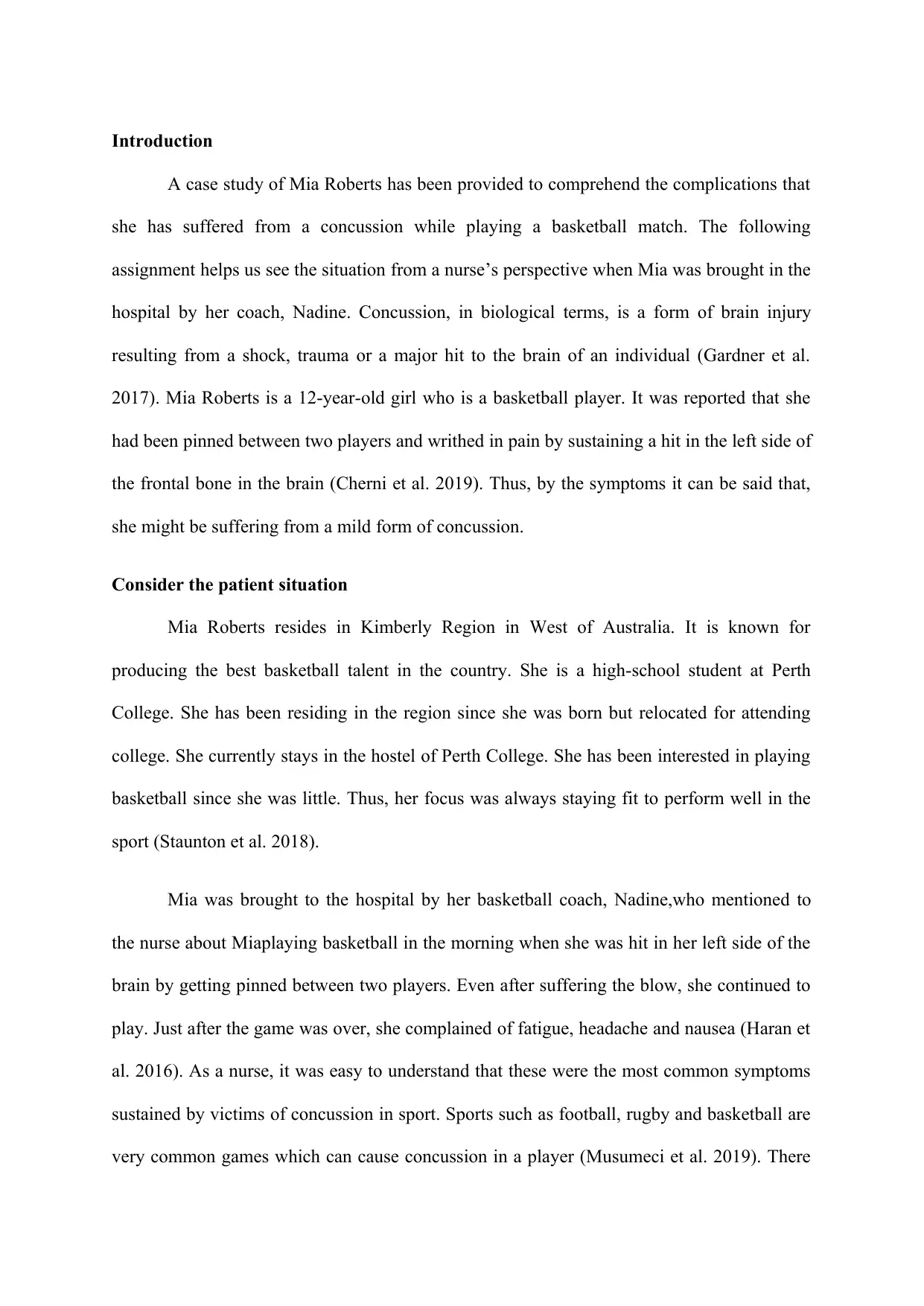
Introduction
A case study of Mia Roberts has been provided to comprehend the complications that
she has suffered from a concussion while playing a basketball match. The following
assignment helps us see the situation from a nurse’s perspective when Mia was brought in the
hospital by her coach, Nadine. Concussion, in biological terms, is a form of brain injury
resulting from a shock, trauma or a major hit to the brain of an individual (Gardner et al.
2017). Mia Roberts is a 12-year-old girl who is a basketball player. It was reported that she
had been pinned between two players and writhed in pain by sustaining a hit in the left side of
the frontal bone in the brain (Cherni et al. 2019). Thus, by the symptoms it can be said that,
she might be suffering from a mild form of concussion.
Consider the patient situation
Mia Roberts resides in Kimberly Region in West of Australia. It is known for
producing the best basketball talent in the country. She is a high-school student at Perth
College. She has been residing in the region since she was born but relocated for attending
college. She currently stays in the hostel of Perth College. She has been interested in playing
basketball since she was little. Thus, her focus was always staying fit to perform well in the
sport (Staunton et al. 2018).
Mia was brought to the hospital by her basketball coach, Nadine,who mentioned to
the nurse about Miaplaying basketball in the morning when she was hit in her left side of the
brain by getting pinned between two players. Even after suffering the blow, she continued to
play. Just after the game was over, she complained of fatigue, headache and nausea (Haran et
al. 2016). As a nurse, it was easy to understand that these were the most common symptoms
sustained by victims of concussion in sport. Sports such as football, rugby and basketball are
very common games which can cause concussion in a player (Musumeci et al. 2019). There
A case study of Mia Roberts has been provided to comprehend the complications that
she has suffered from a concussion while playing a basketball match. The following
assignment helps us see the situation from a nurse’s perspective when Mia was brought in the
hospital by her coach, Nadine. Concussion, in biological terms, is a form of brain injury
resulting from a shock, trauma or a major hit to the brain of an individual (Gardner et al.
2017). Mia Roberts is a 12-year-old girl who is a basketball player. It was reported that she
had been pinned between two players and writhed in pain by sustaining a hit in the left side of
the frontal bone in the brain (Cherni et al. 2019). Thus, by the symptoms it can be said that,
she might be suffering from a mild form of concussion.
Consider the patient situation
Mia Roberts resides in Kimberly Region in West of Australia. It is known for
producing the best basketball talent in the country. She is a high-school student at Perth
College. She has been residing in the region since she was born but relocated for attending
college. She currently stays in the hostel of Perth College. She has been interested in playing
basketball since she was little. Thus, her focus was always staying fit to perform well in the
sport (Staunton et al. 2018).
Mia was brought to the hospital by her basketball coach, Nadine,who mentioned to
the nurse about Miaplaying basketball in the morning when she was hit in her left side of the
brain by getting pinned between two players. Even after suffering the blow, she continued to
play. Just after the game was over, she complained of fatigue, headache and nausea (Haran et
al. 2016). As a nurse, it was easy to understand that these were the most common symptoms
sustained by victims of concussion in sport. Sports such as football, rugby and basketball are
very common games which can cause concussion in a player (Musumeci et al. 2019). There
Paraphrase This Document
Need a fresh take? Get an instant paraphrase of this document with our AI Paraphraser
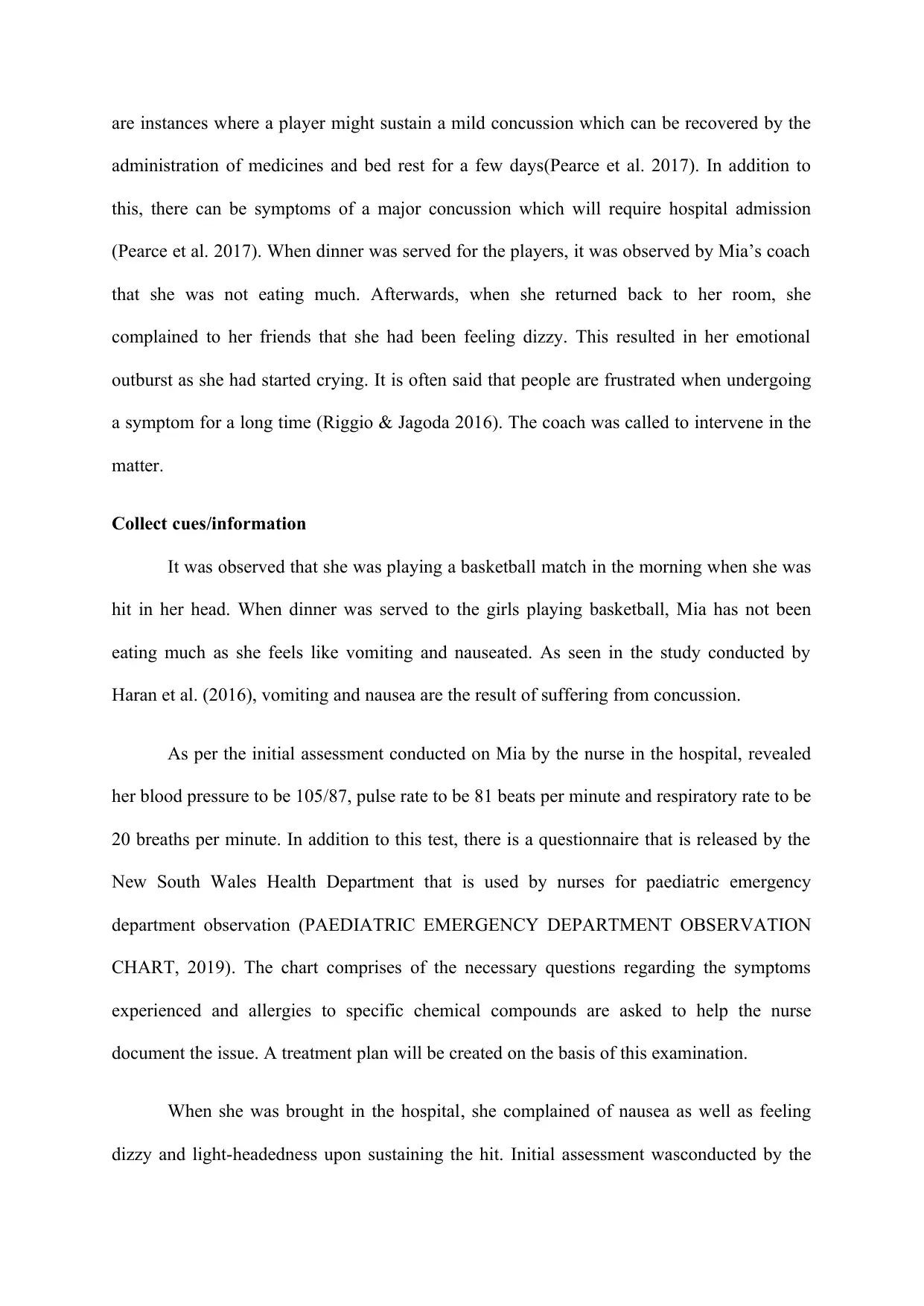
are instances where a player might sustain a mild concussion which can be recovered by the
administration of medicines and bed rest for a few days(Pearce et al. 2017). In addition to
this, there can be symptoms of a major concussion which will require hospital admission
(Pearce et al. 2017). When dinner was served for the players, it was observed by Mia’s coach
that she was not eating much. Afterwards, when she returned back to her room, she
complained to her friends that she had been feeling dizzy. This resulted in her emotional
outburst as she had started crying. It is often said that people are frustrated when undergoing
a symptom for a long time (Riggio & Jagoda 2016). The coach was called to intervene in the
matter.
Collect cues/information
It was observed that she was playing a basketball match in the morning when she was
hit in her head. When dinner was served to the girls playing basketball, Mia has not been
eating much as she feels like vomiting and nauseated. As seen in the study conducted by
Haran et al. (2016), vomiting and nausea are the result of suffering from concussion.
As per the initial assessment conducted on Mia by the nurse in the hospital, revealed
her blood pressure to be 105/87, pulse rate to be 81 beats per minute and respiratory rate to be
20 breaths per minute. In addition to this test, there is a questionnaire that is released by the
New South Wales Health Department that is used by nurses for paediatric emergency
department observation (PAEDIATRIC EMERGENCY DEPARTMENT OBSERVATION
CHART, 2019). The chart comprises of the necessary questions regarding the symptoms
experienced and allergies to specific chemical compounds are asked to help the nurse
document the issue. A treatment plan will be created on the basis of this examination.
When she was brought in the hospital, she complained of nausea as well as feeling
dizzy and light-headedness upon sustaining the hit. Initial assessment wasconducted by the
administration of medicines and bed rest for a few days(Pearce et al. 2017). In addition to
this, there can be symptoms of a major concussion which will require hospital admission
(Pearce et al. 2017). When dinner was served for the players, it was observed by Mia’s coach
that she was not eating much. Afterwards, when she returned back to her room, she
complained to her friends that she had been feeling dizzy. This resulted in her emotional
outburst as she had started crying. It is often said that people are frustrated when undergoing
a symptom for a long time (Riggio & Jagoda 2016). The coach was called to intervene in the
matter.
Collect cues/information
It was observed that she was playing a basketball match in the morning when she was
hit in her head. When dinner was served to the girls playing basketball, Mia has not been
eating much as she feels like vomiting and nauseated. As seen in the study conducted by
Haran et al. (2016), vomiting and nausea are the result of suffering from concussion.
As per the initial assessment conducted on Mia by the nurse in the hospital, revealed
her blood pressure to be 105/87, pulse rate to be 81 beats per minute and respiratory rate to be
20 breaths per minute. In addition to this test, there is a questionnaire that is released by the
New South Wales Health Department that is used by nurses for paediatric emergency
department observation (PAEDIATRIC EMERGENCY DEPARTMENT OBSERVATION
CHART, 2019). The chart comprises of the necessary questions regarding the symptoms
experienced and allergies to specific chemical compounds are asked to help the nurse
document the issue. A treatment plan will be created on the basis of this examination.
When she was brought in the hospital, she complained of nausea as well as feeling
dizzy and light-headedness upon sustaining the hit. Initial assessment wasconducted by the
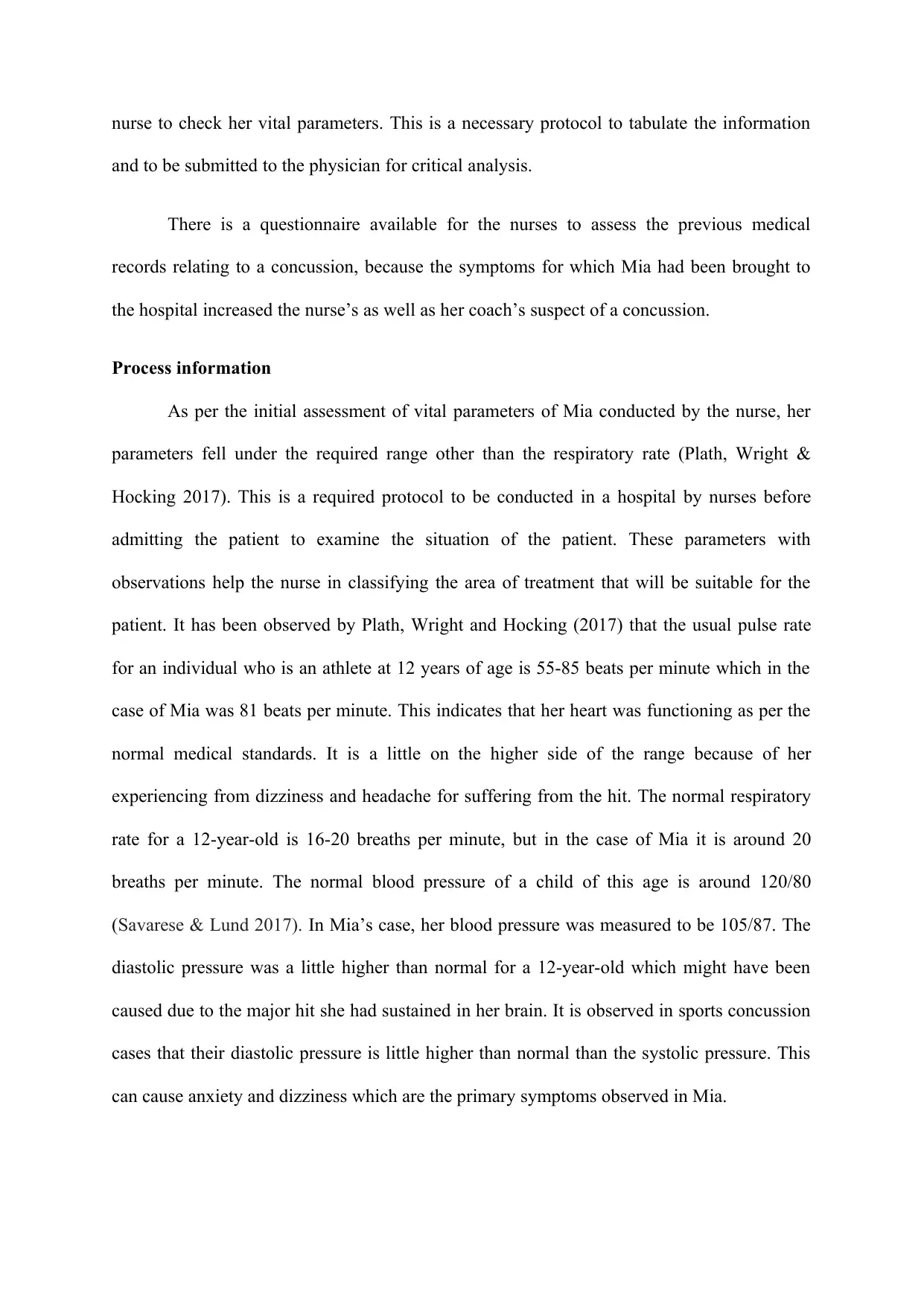
nurse to check her vital parameters. This is a necessary protocol to tabulate the information
and to be submitted to the physician for critical analysis.
There is a questionnaire available for the nurses to assess the previous medical
records relating to a concussion, because the symptoms for which Mia had been brought to
the hospital increased the nurse’s as well as her coach’s suspect of a concussion.
Process information
As per the initial assessment of vital parameters of Mia conducted by the nurse, her
parameters fell under the required range other than the respiratory rate (Plath, Wright &
Hocking 2017). This is a required protocol to be conducted in a hospital by nurses before
admitting the patient to examine the situation of the patient. These parameters with
observations help the nurse in classifying the area of treatment that will be suitable for the
patient. It has been observed by Plath, Wright and Hocking (2017) that the usual pulse rate
for an individual who is an athlete at 12 years of age is 55-85 beats per minute which in the
case of Mia was 81 beats per minute. This indicates that her heart was functioning as per the
normal medical standards. It is a little on the higher side of the range because of her
experiencing from dizziness and headache for suffering from the hit. The normal respiratory
rate for a 12-year-old is 16-20 breaths per minute, but in the case of Mia it is around 20
breaths per minute. The normal blood pressure of a child of this age is around 120/80
(Savarese & Lund 2017). In Mia’s case, her blood pressure was measured to be 105/87. The
diastolic pressure was a little higher than normal for a 12-year-old which might have been
caused due to the major hit she had sustained in her brain. It is observed in sports concussion
cases that their diastolic pressure is little higher than normal than the systolic pressure. This
can cause anxiety and dizziness which are the primary symptoms observed in Mia.
and to be submitted to the physician for critical analysis.
There is a questionnaire available for the nurses to assess the previous medical
records relating to a concussion, because the symptoms for which Mia had been brought to
the hospital increased the nurse’s as well as her coach’s suspect of a concussion.
Process information
As per the initial assessment of vital parameters of Mia conducted by the nurse, her
parameters fell under the required range other than the respiratory rate (Plath, Wright &
Hocking 2017). This is a required protocol to be conducted in a hospital by nurses before
admitting the patient to examine the situation of the patient. These parameters with
observations help the nurse in classifying the area of treatment that will be suitable for the
patient. It has been observed by Plath, Wright and Hocking (2017) that the usual pulse rate
for an individual who is an athlete at 12 years of age is 55-85 beats per minute which in the
case of Mia was 81 beats per minute. This indicates that her heart was functioning as per the
normal medical standards. It is a little on the higher side of the range because of her
experiencing from dizziness and headache for suffering from the hit. The normal respiratory
rate for a 12-year-old is 16-20 breaths per minute, but in the case of Mia it is around 20
breaths per minute. The normal blood pressure of a child of this age is around 120/80
(Savarese & Lund 2017). In Mia’s case, her blood pressure was measured to be 105/87. The
diastolic pressure was a little higher than normal for a 12-year-old which might have been
caused due to the major hit she had sustained in her brain. It is observed in sports concussion
cases that their diastolic pressure is little higher than normal than the systolic pressure. This
can cause anxiety and dizziness which are the primary symptoms observed in Mia.
⊘ This is a preview!⊘
Do you want full access?
Subscribe today to unlock all pages.

Trusted by 1+ million students worldwide
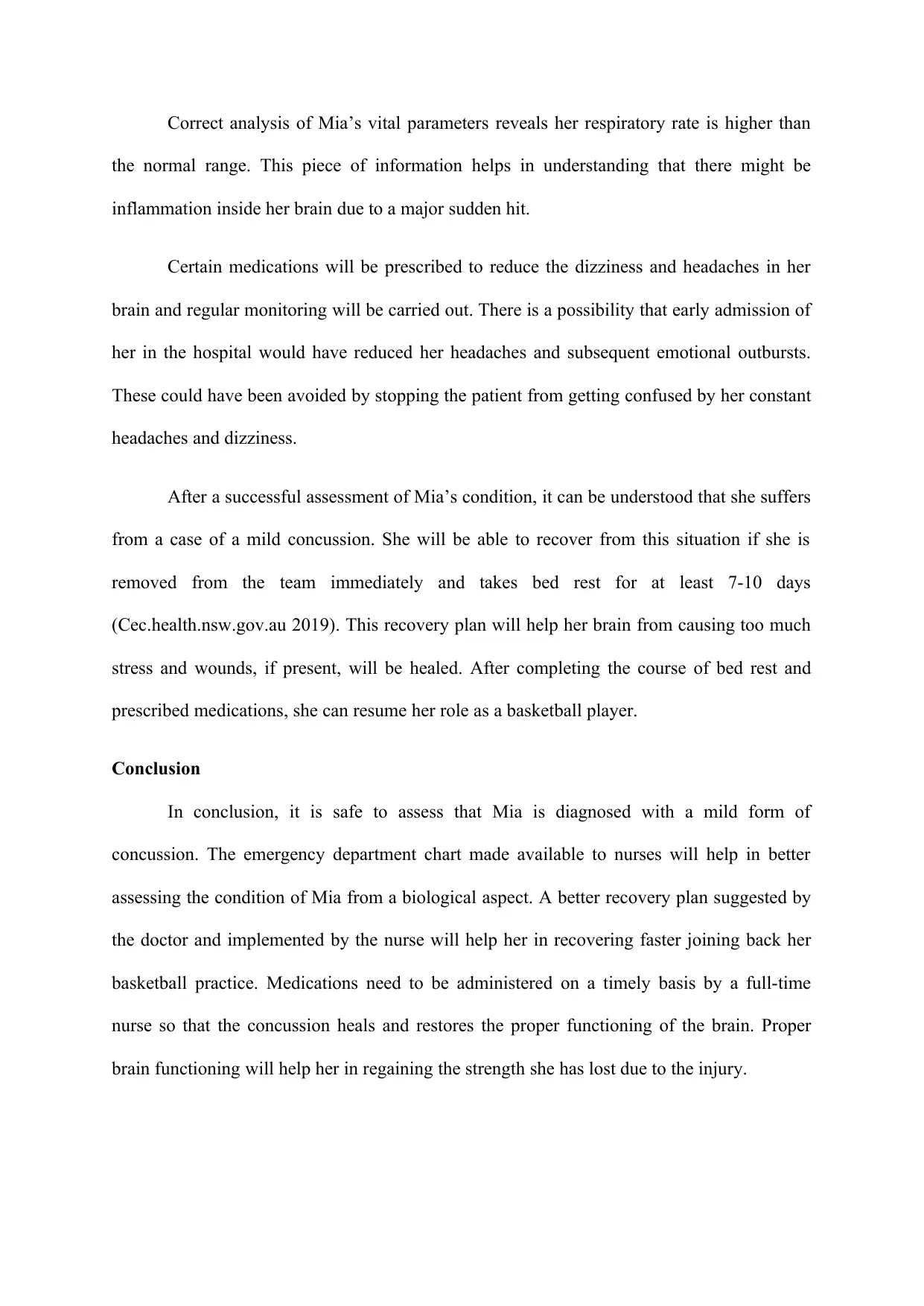
Correct analysis of Mia’s vital parameters reveals her respiratory rate is higher than
the normal range. This piece of information helps in understanding that there might be
inflammation inside her brain due to a major sudden hit.
Certain medications will be prescribed to reduce the dizziness and headaches in her
brain and regular monitoring will be carried out. There is a possibility that early admission of
her in the hospital would have reduced her headaches and subsequent emotional outbursts.
These could have been avoided by stopping the patient from getting confused by her constant
headaches and dizziness.
After a successful assessment of Mia’s condition, it can be understood that she suffers
from a case of a mild concussion. She will be able to recover from this situation if she is
removed from the team immediately and takes bed rest for at least 7-10 days
(Cec.health.nsw.gov.au 2019). This recovery plan will help her brain from causing too much
stress and wounds, if present, will be healed. After completing the course of bed rest and
prescribed medications, she can resume her role as a basketball player.
Conclusion
In conclusion, it is safe to assess that Mia is diagnosed with a mild form of
concussion. The emergency department chart made available to nurses will help in better
assessing the condition of Mia from a biological aspect. A better recovery plan suggested by
the doctor and implemented by the nurse will help her in recovering faster joining back her
basketball practice. Medications need to be administered on a timely basis by a full-time
nurse so that the concussion heals and restores the proper functioning of the brain. Proper
brain functioning will help her in regaining the strength she has lost due to the injury.
the normal range. This piece of information helps in understanding that there might be
inflammation inside her brain due to a major sudden hit.
Certain medications will be prescribed to reduce the dizziness and headaches in her
brain and regular monitoring will be carried out. There is a possibility that early admission of
her in the hospital would have reduced her headaches and subsequent emotional outbursts.
These could have been avoided by stopping the patient from getting confused by her constant
headaches and dizziness.
After a successful assessment of Mia’s condition, it can be understood that she suffers
from a case of a mild concussion. She will be able to recover from this situation if she is
removed from the team immediately and takes bed rest for at least 7-10 days
(Cec.health.nsw.gov.au 2019). This recovery plan will help her brain from causing too much
stress and wounds, if present, will be healed. After completing the course of bed rest and
prescribed medications, she can resume her role as a basketball player.
Conclusion
In conclusion, it is safe to assess that Mia is diagnosed with a mild form of
concussion. The emergency department chart made available to nurses will help in better
assessing the condition of Mia from a biological aspect. A better recovery plan suggested by
the doctor and implemented by the nurse will help her in recovering faster joining back her
basketball practice. Medications need to be administered on a timely basis by a full-time
nurse so that the concussion heals and restores the proper functioning of the brain. Proper
brain functioning will help her in regaining the strength she has lost due to the injury.
Paraphrase This Document
Need a fresh take? Get an instant paraphrase of this document with our AI Paraphraser
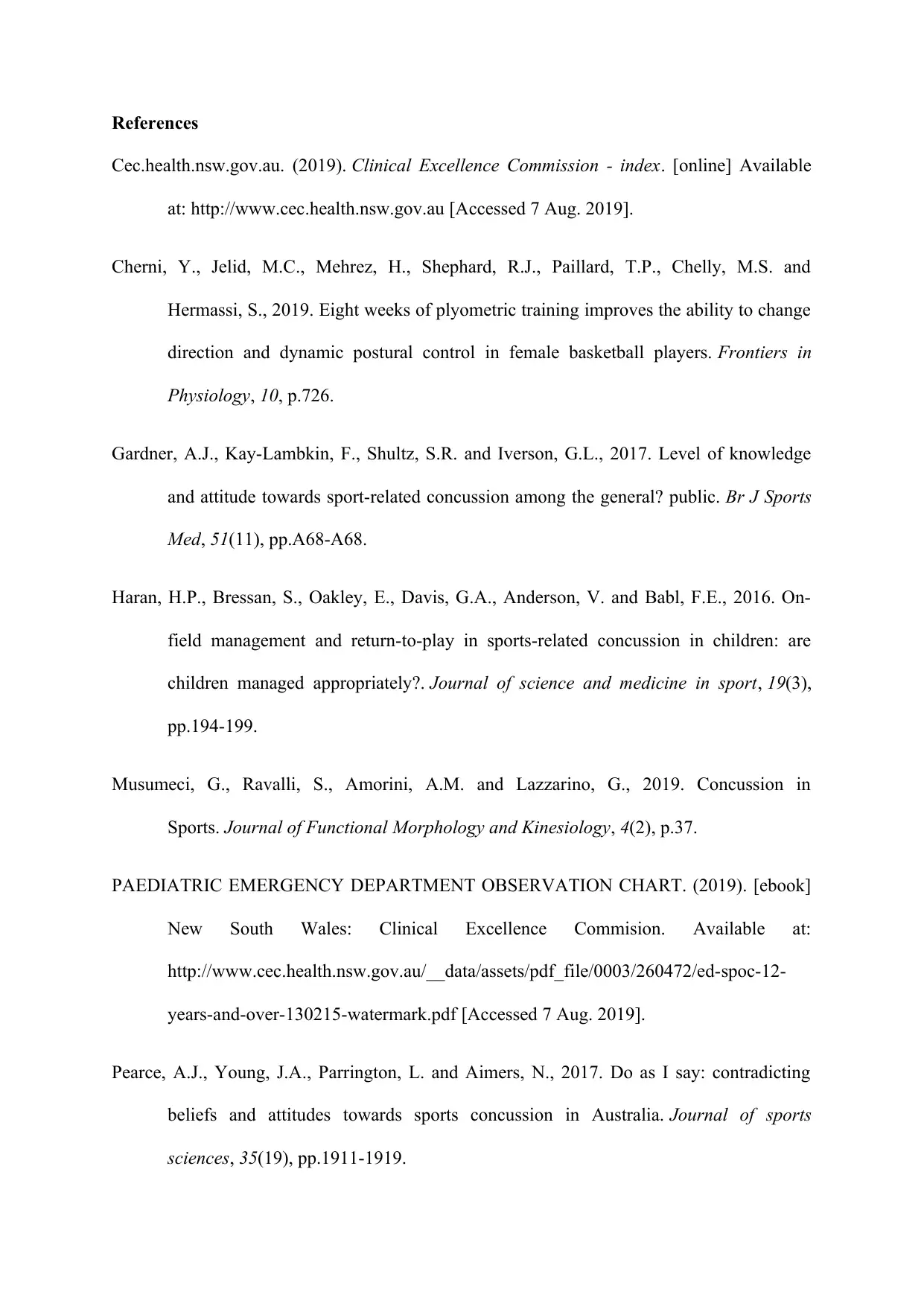
References
Cec.health.nsw.gov.au. (2019). Clinical Excellence Commission - index. [online] Available
at: http://www.cec.health.nsw.gov.au [Accessed 7 Aug. 2019].
Cherni, Y., Jelid, M.C., Mehrez, H., Shephard, R.J., Paillard, T.P., Chelly, M.S. and
Hermassi, S., 2019. Eight weeks of plyometric training improves the ability to change
direction and dynamic postural control in female basketball players. Frontiers in
Physiology, 10, p.726.
Gardner, A.J., Kay-Lambkin, F., Shultz, S.R. and Iverson, G.L., 2017. Level of knowledge
and attitude towards sport-related concussion among the general? public. Br J Sports
Med, 51(11), pp.A68-A68.
Haran, H.P., Bressan, S., Oakley, E., Davis, G.A., Anderson, V. and Babl, F.E., 2016. On-
field management and return-to-play in sports-related concussion in children: are
children managed appropriately?. Journal of science and medicine in sport, 19(3),
pp.194-199.
Musumeci, G., Ravalli, S., Amorini, A.M. and Lazzarino, G., 2019. Concussion in
Sports. Journal of Functional Morphology and Kinesiology, 4(2), p.37.
PAEDIATRIC EMERGENCY DEPARTMENT OBSERVATION CHART. (2019). [ebook]
New South Wales: Clinical Excellence Commision. Available at:
http://www.cec.health.nsw.gov.au/__data/assets/pdf_file/0003/260472/ed-spoc-12-
years-and-over-130215-watermark.pdf [Accessed 7 Aug. 2019].
Pearce, A.J., Young, J.A., Parrington, L. and Aimers, N., 2017. Do as I say: contradicting
beliefs and attitudes towards sports concussion in Australia. Journal of sports
sciences, 35(19), pp.1911-1919.
Cec.health.nsw.gov.au. (2019). Clinical Excellence Commission - index. [online] Available
at: http://www.cec.health.nsw.gov.au [Accessed 7 Aug. 2019].
Cherni, Y., Jelid, M.C., Mehrez, H., Shephard, R.J., Paillard, T.P., Chelly, M.S. and
Hermassi, S., 2019. Eight weeks of plyometric training improves the ability to change
direction and dynamic postural control in female basketball players. Frontiers in
Physiology, 10, p.726.
Gardner, A.J., Kay-Lambkin, F., Shultz, S.R. and Iverson, G.L., 2017. Level of knowledge
and attitude towards sport-related concussion among the general? public. Br J Sports
Med, 51(11), pp.A68-A68.
Haran, H.P., Bressan, S., Oakley, E., Davis, G.A., Anderson, V. and Babl, F.E., 2016. On-
field management and return-to-play in sports-related concussion in children: are
children managed appropriately?. Journal of science and medicine in sport, 19(3),
pp.194-199.
Musumeci, G., Ravalli, S., Amorini, A.M. and Lazzarino, G., 2019. Concussion in
Sports. Journal of Functional Morphology and Kinesiology, 4(2), p.37.
PAEDIATRIC EMERGENCY DEPARTMENT OBSERVATION CHART. (2019). [ebook]
New South Wales: Clinical Excellence Commision. Available at:
http://www.cec.health.nsw.gov.au/__data/assets/pdf_file/0003/260472/ed-spoc-12-
years-and-over-130215-watermark.pdf [Accessed 7 Aug. 2019].
Pearce, A.J., Young, J.A., Parrington, L. and Aimers, N., 2017. Do as I say: contradicting
beliefs and attitudes towards sports concussion in Australia. Journal of sports
sciences, 35(19), pp.1911-1919.
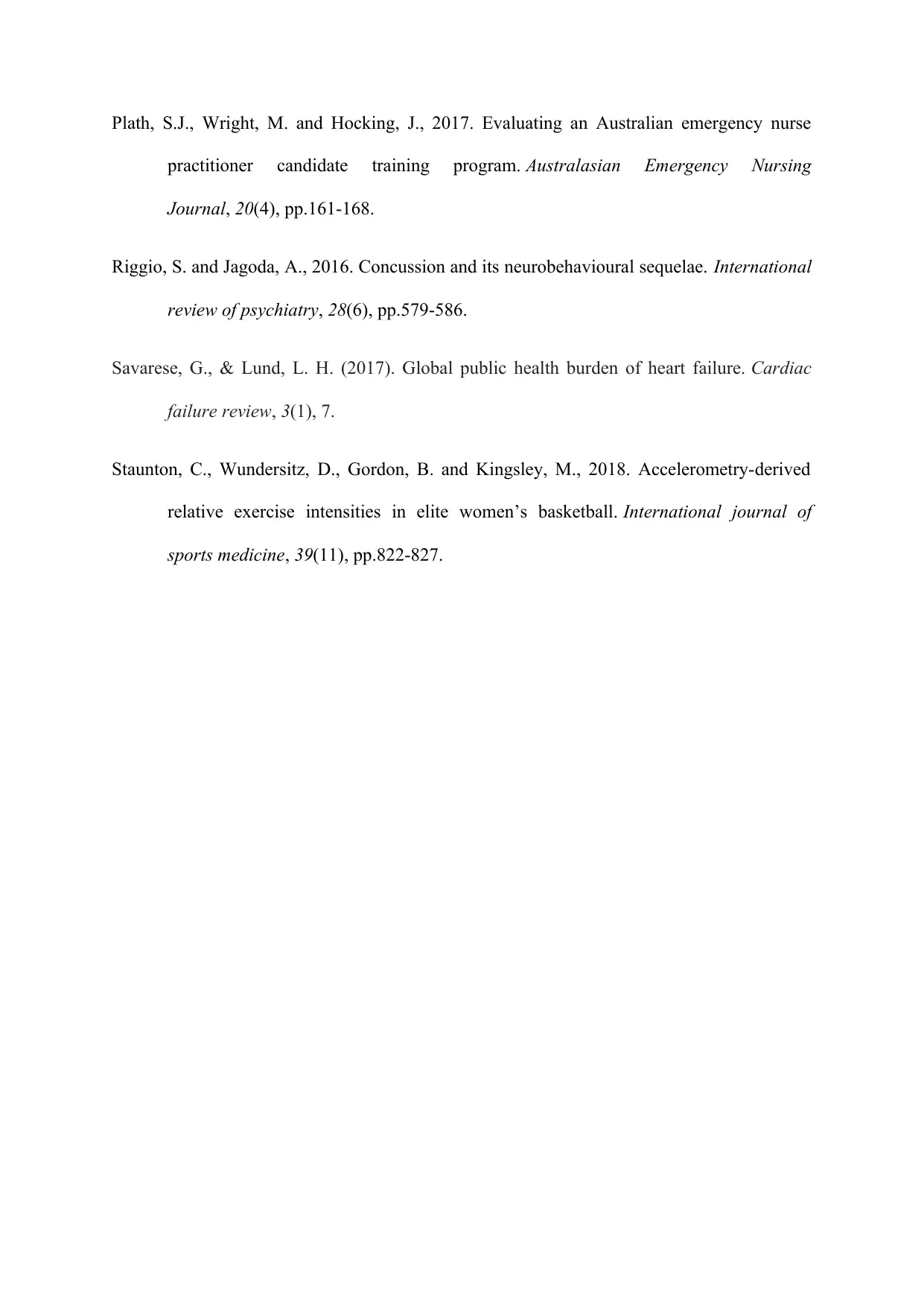
Plath, S.J., Wright, M. and Hocking, J., 2017. Evaluating an Australian emergency nurse
practitioner candidate training program. Australasian Emergency Nursing
Journal, 20(4), pp.161-168.
Riggio, S. and Jagoda, A., 2016. Concussion and its neurobehavioural sequelae. International
review of psychiatry, 28(6), pp.579-586.
Savarese, G., & Lund, L. H. (2017). Global public health burden of heart failure. Cardiac
failure review, 3(1), 7.
Staunton, C., Wundersitz, D., Gordon, B. and Kingsley, M., 2018. Accelerometry-derived
relative exercise intensities in elite women’s basketball. International journal of
sports medicine, 39(11), pp.822-827.
practitioner candidate training program. Australasian Emergency Nursing
Journal, 20(4), pp.161-168.
Riggio, S. and Jagoda, A., 2016. Concussion and its neurobehavioural sequelae. International
review of psychiatry, 28(6), pp.579-586.
Savarese, G., & Lund, L. H. (2017). Global public health burden of heart failure. Cardiac
failure review, 3(1), 7.
Staunton, C., Wundersitz, D., Gordon, B. and Kingsley, M., 2018. Accelerometry-derived
relative exercise intensities in elite women’s basketball. International journal of
sports medicine, 39(11), pp.822-827.
⊘ This is a preview!⊘
Do you want full access?
Subscribe today to unlock all pages.

Trusted by 1+ million students worldwide
1 out of 6
Your All-in-One AI-Powered Toolkit for Academic Success.
+13062052269
info@desklib.com
Available 24*7 on WhatsApp / Email
![[object Object]](/_next/static/media/star-bottom.7253800d.svg)
Unlock your academic potential
Copyright © 2020–2025 A2Z Services. All Rights Reserved. Developed and managed by ZUCOL.


